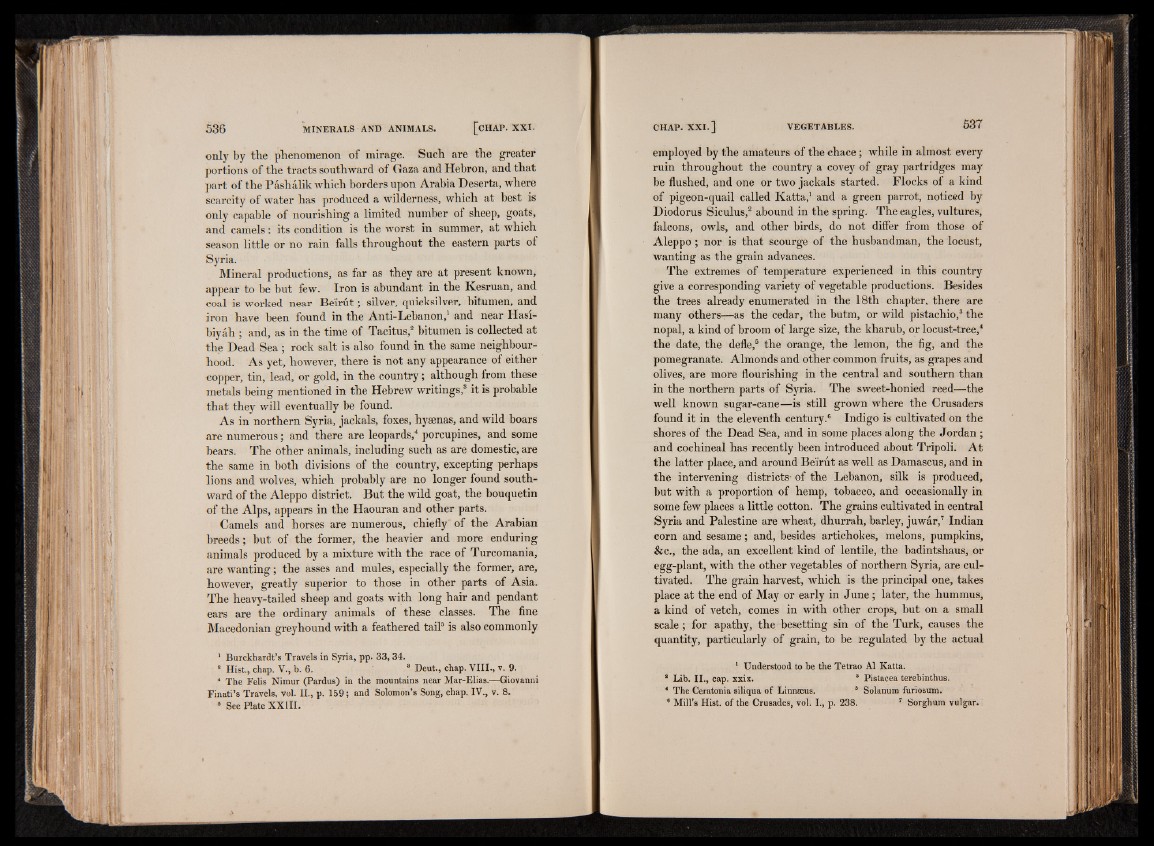
only by the phenomenon of mirage. Such are the greater
portions of the tracts southward of Gaza and Hebron, and that
part of the Pashalik which borders upon Arabia Deserta, where
scarcity of water has produced a wilderness, which at best is
only capable of nourishing a limited number of sheep, goats,
and camels: its condition is the worst in summer, at which
season little or no rain falls throughout the eastern parts of
Syria.
Mineral productions, as far as they are at present known,
appear to be but few. Iron is abundant in the Kesruan, and
coal is worked near Beirut; silver, quicksilver, bitumen, and
iron have been found in the Anti-Lebanon,1 and near Hasi-
biyah ; and, as in the time of Tacitus,2 bitumen is collected at
the Dead Sea ; rock salt is also found in the same neighbourhood.
As yet, however, there is not any appearance of either
copper, tin, lead, or gold, in the country; although from these
metals being mentioned in the Hebrew writings,3 it is probable
that they will eventually be found.
As in northern Syria, jackals, foxes, hyaenas, and wild boars
are numerous; and there are leopards,4 porcupines, and some
bears. The other animals, including such as are domestic, are
the same in both divisions of the country, excepting perhaps
lions and wolves, which probably are no longer found southward
of the Aleppo district. But the wild goat, the bouquetin
of the Alps, appears in the Haouran and other parts.
Camels and horses are numerous, chiefly' of the Arabian
breeds; but of the former, the heavier and more enduring
animals produced by a mixture with the race of Turcomania,
are wanting; the asses and mules, especially the former, are,
however, greatly superior to those in other parts of Asia.
The heavy-tailed sheep and goats with long hair and pendant
ears are the ordinary animals of these classes. The fine
Macedonian greyhound with a feathered tail5 is also commonly
1 BurckhaTdt’s Travels in Syria, pp. 33,34.
! Hist., chap. V., b. 6. 8 Deut., chap. V III., v. 9.
4 The Felis Nimur (Pardus) in the mountains near Mar-Elias.—Giovanni
Finati’s Travels, vol. II., p. 159; and Solomon’s Song, chap. IV., v. 8.
5 See Plate XXIII.
employed by the amateurs of the chace; while in almost every
ruin throughout the country a covey of gray partridges may
be flushed, and one or two jackals started. Flocks of a kind
of pigeon-quail called Katta,1 and a green parrot, noticed by
Diodorus Siculus,2 abound in the spring. The eagles, vultures,
falcons, owls, and other birds, do not differ from those of
Aleppo; nor is that scourge of the husbandman, the locust,
wanting as the grain advances.
The extremes of temperature experienced in this country
give a corresponding variety of vegetable productions. Besides
the trees already enumerated in the 18th chapter, there are
many others—as the cedar, the butm, or wild pistachio,3 the
nopal, a kind of broom of large size, the kharub, or locust-tree,4
the date, the defle,5 the orange, the lemon, the fig, and the
pomegranate. Almonds and other common fruits, as grapes and
olives, are more flourishing in the central and southern than
in the northern parts of Syria. The sweet-honied reed—the
well known sugar-cane—is still grown where the Crusaders
found it in the eleventh century.6 Indigo is cultivated on the
shores of the Dead Sea, and in some places along the Jordan ;
and cochineal has recently been introduced about Tripoli. At
the latter place, and around Beirut as well as Damascus, and in
the intervening districts- of the Lebanon, silk is produced,
but with a proportion of hemp, tobacco, and occasionally in
some few places a little cotton. The grains cultivated in central
Syria and Palestine are wheat, dhurrah, barley, juwar,7 Indian
corn and sesame; and, besides artichokes, melons, pumpkins,
&c., the ada, an excellent kind of lentile, the badintshaus, or
egg-plant, with the other vegetables of northern Syria, are cultivated.
The grain harvest, which is the principal one, takes
place at the end of May or early in June; later, the hummus,
a kind of vetch, comes in with other crops, but on a small
scale; for apathy, the besetting sin of the Turk, causes the
quantity, particularly of grain, to be regulated by the actual
1 Understood to be the Tetrao A1 Katta.
* Lib. II., cap. xxix. 8 Pistacea terebinthus.
4 The Ceratonia siliqua of Linnaeus. 8 Solanum furiosum.
* Mill’s Hist, of the Crusades, vol. I., p. 238. 7 Sorghum vulgar.